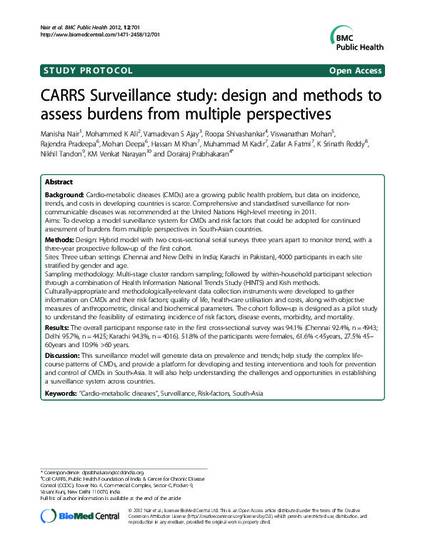
Background
Cardio-metabolic diseases (CMDs) are a growing public health problem, but data on incidence, trends, and costs in developing countries is scarce. Comprehensive and standardised surveillance for non-communicable diseases was recommended at the United Nations High-level meeting in 2011.
Aims: To develop a model surveillance system for CMDs and risk factors that could be adopted for continued assessment of burdens from multiple perspectives in South-Asian countries. Methods
Design: Hybrid model with two cross-sectional serial surveys three years apart to monitor trend, with a three-year prospective follow-up of the first cohort.
Sites: Three urban settings (Chennai and New Delhi in India; Karachi in Pakistan), 4000 participants in each site stratified by gender and age.
Sampling methodology: Multi-stage cluster random sampling; followed by within-household participant selection through a combination of Health Information National Trends Study (HINTS) and Kish methods.
Culturally-appropriate and methodologically-relevant data collection instruments were developed to gather information on CMDs and their risk factors; quality of life, health-care utilisation and costs, along with objective measures of anthropometric, clinical and biochemical parameters. The cohort follow-up is designed as a pilot study to understand the feasibility of estimating incidence of risk factors, disease events, morbidity, and mortality. Results
The overall participant response rate in the first cross-sectional survey was 94.1% (Chennai 92.4%, n = 4943; Delhi 95.7%, n = 4425; Karachi 94.3%, n = 4016). 51.8% of the participants were females, 61.6% < 45years, 27.5% 45–60years and 10.9% >60 years. Discussion
This surveillance model will generate data on prevalence and trends; help study the complex life-course patterns of CMDs, and provide a platform for developing and testing interventions and tools for prevention and control of CMDs in South-Asia. It will also help understanding the challenges and opportunities in establishing a surveillance system across countries.
Available at: http://works.bepress.com/zafar_fatmi/1/
